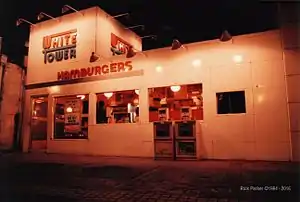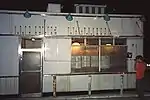White Tower Hamburgers
White Tower Hamburgers was a fast food restaurant chain that was founded in 1926 in Milwaukee, Wisconsin. With its similar white fortress-like buildings and menu it is considered to be an imitator of White Castle chain that was founded in 1921.[2] The chain was successful and expanded to other cities, including Chicago, Indianapolis, Cleveland, Detroit, Philadelphia, Pittsburgh, New York City, Albany, Boston, Richmond, Virginia, and as far south as Sarasota, Florida.[3][4] During the Great Depression, White Tower sold hamburgers for five cents. The whiteness of the restaurant was meant among other things to evoke the notion of hygienic conditions, and the chain had staff dressed as nurses, dubbed the "Towerettes," to help make this argument.[5]
 White Tower restaurant in Norfolk, Virginia in 1984. | |
| Type | Restaurant |
|---|---|
| Industry | Fast Food Restaurant |
| Genre | Fast Food Restaurant |
| Fate | Defunct |
| Founded | 1926 in Milwaukee, Wisconsin [1] |
| Founder | John E. Saxe Thomas E. Saxe[1] |
| Defunct | 2004 |
| Headquarters | |
Number of locations | 230 peak (1950s) |
| Products | Hamburgers Soft drinks |
At its peak in the 1950s there were 230 White Tower locations. The chain began a slow decline. The last location, in Toledo, Ohio, is still open and operational.
History
John E. Saxe and Thomas E. Saxe started White Tower Hamburgers after investigating various White Castle locations, observing operations and hiring a White Castle operator. The first location opened near Marquette University in Milwaukee, Wisconsin.[1] By the end of 1927, there were six locations in Milwaukee and Racine, Wisconsin. In 1929, White Tower put 30 locations in Detroit alone. Despite the Depression, White Tower expanded to 130 locations.[6] White Tower placed many of its restaurants near train and trolley stops.[1]
Lawsuit

In 1929, White Castle sued White Tower in Minnesota for unfair competition and White Tower counter-sued in Michigan as White Tower had arrived in Michigan first. The Minnesota case ended in 1930 in favor of White Castle, forcing White Tower to end its use of similar building designs, slogans and name along with a $82,000 judgment.[7] The Michigan case dragged on until 1934, revealing the hiring away of a White Castle location operator and photographing of the latest White Castle to keep up on design. The United States Court of Appeals for the Sixth Circuit later affirmed the lower court's rulings that they had copied White Castle deliberately.[8] White Castle refrained from forcing a name change for White Tower but did require new locations to pay a royalty fee, and to send photos of the locations. Having to change its look, White Tower first used an art deco, then modernistic designs.[9] Territorially, White Tower and White Castle stayed away from each other from then on.[1]
Peak and decline


In 1941, White Tower Management Corporation moved its headquarters to Six Suburban Ave., Stamford, Connecticut.[10] At its peak in the mid-1950s, the chain had 230 stores in several states. It tested the "Tower-O-Matic" automated restaurant in the 1950s and 60s with little success.[3] It also attempted a sit-down restaurant called Marbett's.[11] Many later suburban White Tower restaurants featured curb service with car hops.
Brock Saxe took over as president of White Tower Management Corporation in 1970 from his father, T. E. Saxe, when he retired. Brock changed the name of White Tower Corporation to Tombrock Corporation on the corporation's 50th anniversary as it also owns a chain of steakhouses called Brock's.[12] With the migration of people to the suburbs and most of the White Tower locations in the city, by 1979 only 80 Tombrock Corporation-owned locations remained. Tombrock Corporation branched out i|nto franchising Burger Kings and Golden Skillet Chicken.[6] Today, Tombrock Corporation, having exited the restaurant business as an operator, is a real estate investment and management company based in New Canaan, Connecticut.[13] The last White Tower Restaurant is located at 1515 West Sylvania Avenue in Toledo, Ohio. In 2004, the company's trademark was listed as expired in 2005.[2][14]
See also
References
- Hogan, David Gerard (1997). Selling 'em by the Sack: White Castle and the Creation of American Food (1st ed.). NYU Press. pp. 52–55. ISBN 0-8147-3567-3.
- "10 Restaurant Chains That Flopped". HowStuffWorks. October 27, 2009. Retrieved 3 December 2017.
- "Roadside Highlight: White Tower Hamburgers". Buildings with Taste: Fast Food Restaurants. Archived from the original on 6 September 2008. Retrieved 2008-06-18.
- Sarasota News Newspaper Archives https://newspaperarchive.com/sarasota-news-may-13-1960-p-5/. Retrieved 27 June 2020. Missing or empty
|title=(help) - As Hamburgers Go, So Goes America? The Economist, Aug 21st 1997
- Funderburg, Anne Cooper (2001). "Make it Quick!". Sundae Best: A History of Soda Fountains. Popular Press. p. 140. ISBN 0-87972-854-X. Retrieved 2008-06-19.
- "8) White Tower from The 11 Biggest Failed Chain Restaurants Slideshow". The Daily Meal. Retrieved 3 December 2017.
- White Tower System Inc. v. White Castle System of Eating Houses Corp., 1937
- Marzlock, Ron (13 November 2014). "A burger joint called White Tower". Queens Chronicle. Queens Chronicle. Retrieved 3 December 2017.
- "New Investment Advisor Locates in Historic Structure at Six Suburban Ave., Stamford, CT". Choyce Peterson. 2007-10-29. Archived from the original on December 5, 2008. Retrieved June 19, 2008.
- "White Tower & Marbett's". dvrbs.com. Retrieved 2008-06-19.
- Swart, Hannah W. (September 1980). "Bookmarks/Wisconsin: White Towers review". Wisconsin Academy Review. Madison, Wisconsin: Wisconsin Academy of Sciences, Arts and Letters. 26 (4): 48. Retrieved June 19, 2008.
- History of Tombrock
- "Trademark Status & Document Retrieval". tsdr.uspto.gov. Retrieved 3 December 2017.
- Stamford, Ct-True facts-1977 Stamford
External links
- Wisconsin Historical Society article on White Tower at the Wayback Machine (archived September 6, 2008)
- Model of a White Tower restaurant
- White Tower and Marbetts